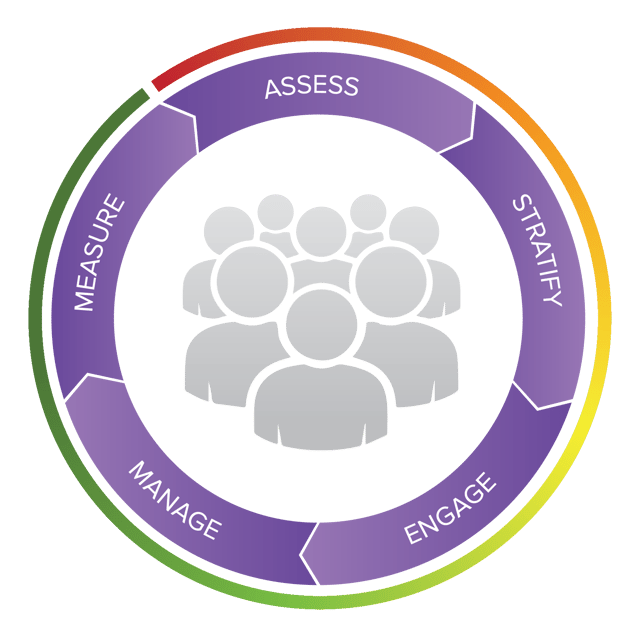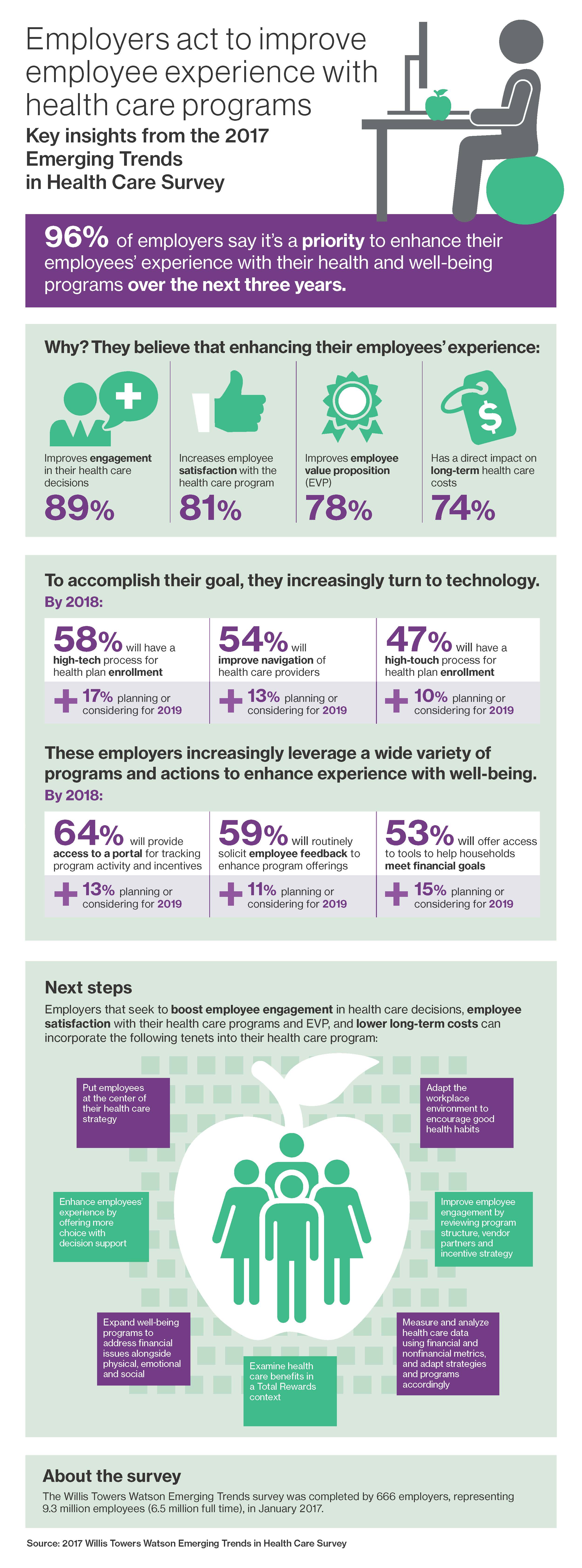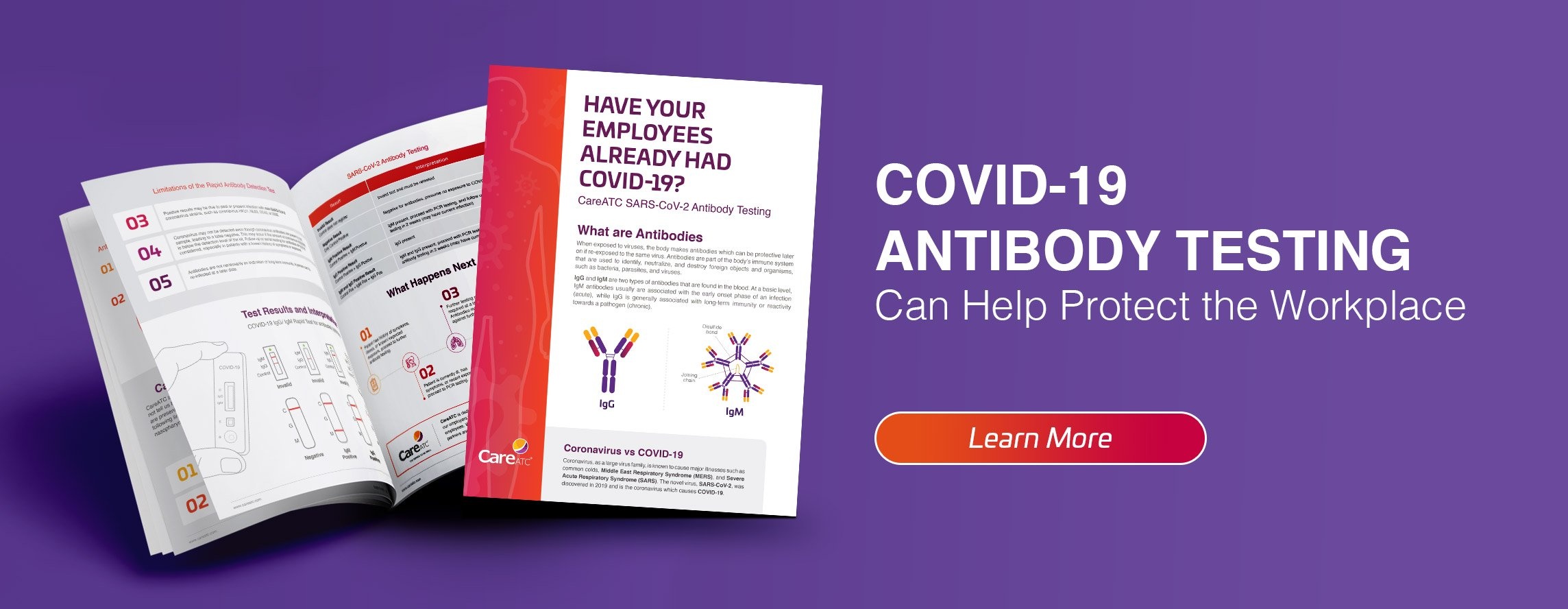
It’s no secret that unhealthy employees are less engaged and more apt to affect your bottom-line. Employers have looked for ways to mitigate risk by motivating employees to live healthier lives. With an overwhelming majority of employers planning to implement a health and wellness program in 2018, employers are taking greater aim at intervention, not just prevention.
A report by Towers Watson indicates that 96% of employers plan to prioritize health and well-being program over the next three years. Why the interest? Well, employers strongly believe that these types of programs will enhance their employees’ experience at the workplace. Let’s look at the numbers:
- 89% of employers say that health and wellness programs improve employee engagement in their health care decisions
- 81% of employers say that health and wellness programs increase employee satisfaction with the health care program
- 78% of employers say that health and wellness programs improve their employee value proposition (EVP)
- 74% of employers say that health and wellness programs have a direct impact on long-term health care costs
It’s clear: health and wellness programs aren’t just tools for prevention, but also an opportunity to improve employee satisfaction, encourage employees and increase the overall employee value proposition. Perhaps, even more, appealing to the business case, is the fact that these types of programs lower long-term costs by encouraging employees to make better healthcare decisions. But even short-term savings can be experienced by focusing on the key culprit to healthcare costs: chronic disease.

In the United States, chronic disease is at an all-time high. The cost to employers (and employees) is troubling and unsustainable. In the largest study of its kind, researchers from the University of Michigan looked at 10 modifiable health risks in roughly 223,500 people across seven industries. In this study, modifiable risks are conditions or behaviors that employees can improve or eliminate by making healthier choices.
The study found that the average health care cost for a healthy employee was roughly $3,000, and roughly $10,000 for an employee with at least one medical condition. In addition, modifiable behaviors and conditions accounted for about $750 for healthy employees and about $2,600 for those with pre-existing health problems. It’s no wonder why employers are turning to health and wellness programs to mitigate risk by modifying behavior.
This brings us to the three elements every sustainable health and wellness program needs: accessibility integration, and incentives. Let’s break each one down.
1) Integration
A fully integrated health and wellness program can have a profound impact on the health of your employees and your healthcare spend. There are five main phases to program integration: assess, stratify, engage, manage and measure.

Types of third-party products and services that facilitate each phase.
Assess |
A personal health assessment should be the foundation for all of your program efforts. The powerful information derived in this process provides a snapshot of the health of your population on an aggregate level. This information is then used to design a program that supports the unique needs of your group. |
Stratify |
The stratification process is key to targeting the most at-risk members of the population. By identifying the low, moderate, and high-risk individuals, a third-party vendor can design a sophisticated wellness program that targets each group in a strategic way. From 1:1 health coaching, group coaching, to corporate wellness challenges, each risk group will receive targeted content and access to unique resources that best serve their needs. |
Engage |
Engagement is key to a successful health and wellness program, and partnering with a wellness vendor with the expertise your employees need will drive trust. In addition to providing evidence-based consulting on incentive design and communication strategy, a trusted vendor can help centralize information and incentive management on a web-based portal. |
Manage |
To target the moderate to high-risk population, 1:1 and group coaching is a great tool to drive motivation and accountability. For self-funded employers, launching an onsite or near-site clinic is a proven way to tackle disease and amplify healthcare savings. With a dedicated primary care clinic, your high-risk population can engage in an evidence-based chronic disease management program – participating in periodic visits with a physician, complete with no-cost medication to improve adherence. Small and mid-sized employers can experience the same benefits in a shared clinic model. |
Measure |
Data-driven decisions are essential for any health and wellness program. Whichever partner you consider, make sure that the analytics platform you have access to answers the following questions: 1) What is the health risk level of my organization?; 2) How engaged are my employees?; and 3) How much money am I saving? |
Free Download: Sample Personal Health Assessment Summary
2) Accessibility
For your program to be successful, you need to make the right thing easy. Turning back to the study, we find that 64% of employers plan to provide access to a portal for tracking program activity and incentives. Tracking program activity and incentives with a web-based portal are essential. With real-time data, you can see how engaged your employees are and do more of what works at the start of each initiative. Apart from technological accessibility, there is a high-level aspect of accessibility I’d like to talk about here.
While implementing a wellness program is a great start, employers are taking things to the next level by offering employer-sponsored healthcare. By offering convenient, no-cost access to primary, employers can amplify their health and wellness strategy and take control of healthcare costs. Employees and their families benefit from painless appointment scheduling, longer appointment times with providers, prescription drug dispensation and labs on-site.
Watch an On-Site Clinic in Action
-
Speed1x
-
QualityAuto

Thanks for reporting a problem. We'll attach technical data about this session to help us figure out the issue. Which of these best describes the problem?
Any other details or context?
Related Article: 5 Benefits of a Shared Clinic Model
3) Incentives
According to a 2015 Rand Corporation study, incentives are associated with higher participation rates in wellness programs, by about 20 percentage points. Employees show that they need at least $100 in incentives to approach the participation rates surrounding quality wellness plans. But there are some other interesting findings that might surprise you.
“While incentives seem to be effective at increasing program uptake, they are not a panacea. Offering a rich, well-designed program is almost as effective at boosting employee participation rates as incentivizing employees to join more-limited ones. Our findings question whether employers’ enthusiasm for incentives, which have the unintended consequence of shifting cost to employees with poor health, is warranted.” – Rand Corporation, 2015.
According to the study larger incentives don’t work better, penalties are more powerful than rewards, and comprehensive programs have the highest participation. From the study, we can effectively conclude that more rewards isn’t the answer, but rather building a better health and wellness program. So, what does a better program look like? For starters, a better program includes providing comprehensive plans, covering health screening, lifestyle improvement, and disease management – all ideally anchored by an on-site or near-site primary care clinic.
Next Steps
As employers take action to improve employee health and wellness, the 2017 Emerging Trends in Health Care Survey recommends the following for employers who seek to boost employee engagement in health care decision, employee satisfaction with their health care programs and lower long-term costs:
- Put employees at the center of your healthcare strategy
- Adapt the workplace environment to encourage good health habits
- Enhance employees’ experience by offering more choice with decision support (i.e., health coaching; chronic disease management)
- Improve employee engagement by reviewing program structure, vendor partners, and incentive strategy
- Expand well-being programs to address financial issues alongside physical, emotional and social
- Examine health care benefits in a Total Rewards context
- Measure and analyze healthcare data using financial and nonfinancial metrics, and adapt strategies and programs accordingly
Infographic: 2017 Willis Towers Watson Emerging Trends in Health Care Survey

Reference
- Incentives for Workplace Wellness Programs, Rand Corporation 2015.
- The Portion of Health Care Costs Associated with Lifestyle-Related Modifiable Health Risks Based on a Sample of 223,461 Employees in Seven Industries: The UM-HMRC Study, 2015.
- Willis Towers Watson Emerging Trends in Health Care Survey, 2017.


 Posted by
Posted by


